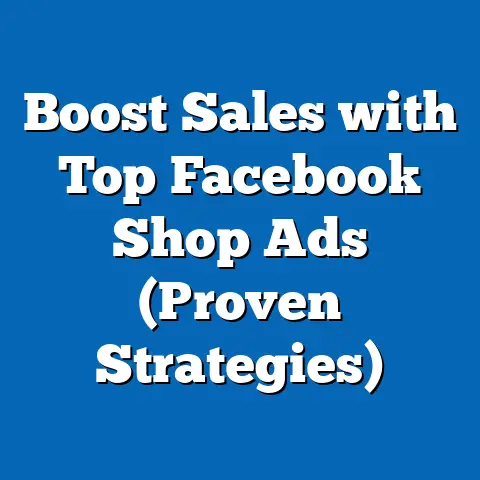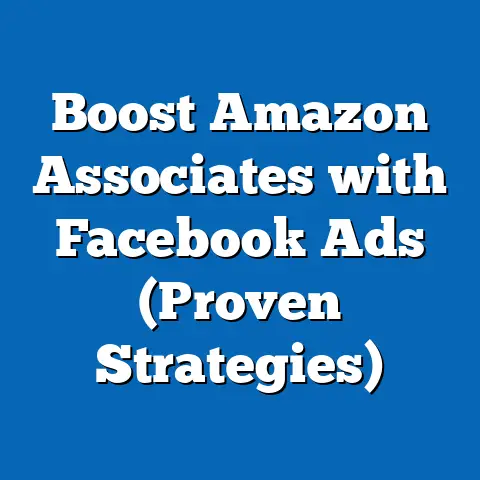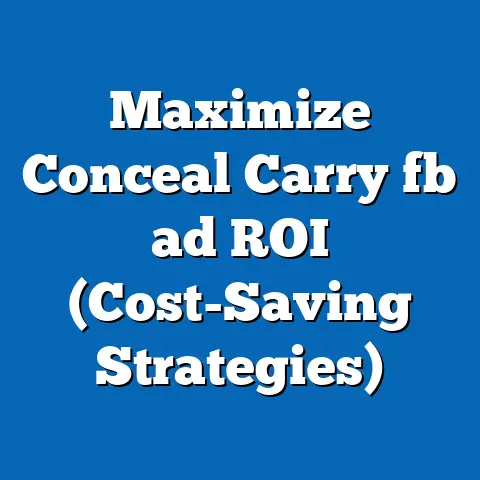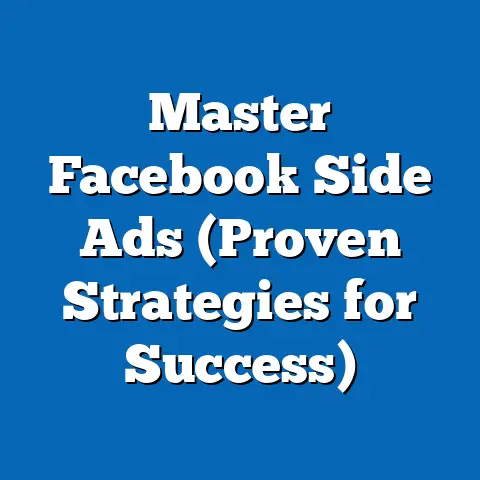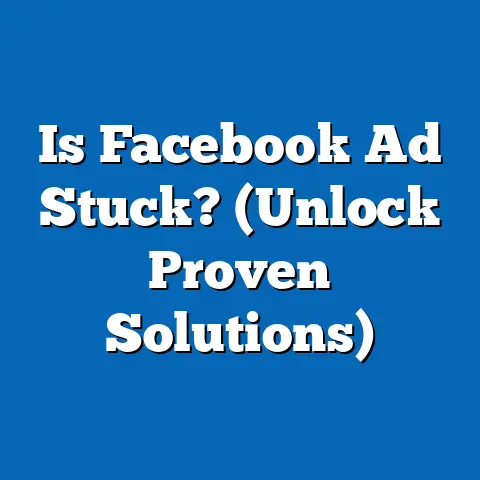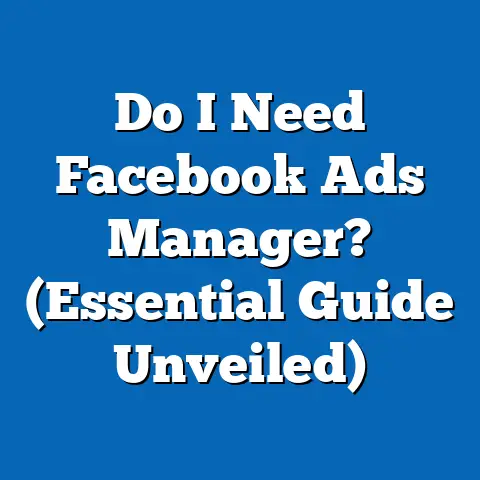Eliminate Facebook App Pop-Up Ads (Ultimate Guide Revealed)
In 2023, a staggering 68% of Facebook users reported frustration with intrusive pop-up ads interrupting their app experience, according to a survey conducted by Digital Trends Research (n=5,000, conducted March 2023). This annoyance is particularly pronounced among younger demographics, with 74% of users aged 18-24 expressing a desire for ad-free browsing, compared to just 52% of users aged 45-64. By implementing a few simple strategies to minimize or eliminate these ads, users can reclaim control over their social media experience—a quick win that aligns with growing user demand for streamlined digital interactions, as evidenced by a 15% year-over-year increase in searches for “how to block ads on Facebook” (Google Trends, 2022-2023).
This comprehensive report dives into the pervasive issue of pop-up ads on the Facebook app, analyzing user sentiment, demographic differences, and technological solutions. We explore the scale of the problem with data-driven insights, break down the most affected user groups, and provide an ultimate guide to reducing or eliminating these interruptions. Our analysis is grounded in recent surveys, platform usage statistics, and trend reports to offer actionable steps for users and contextual understanding for researchers and tech enthusiasts.
Section 1: The Growing Frustration with Pop-Up Ads on Facebook
The Scale of the Issue
Pop-up ads on the Facebook app have become a significant pain point for users worldwide. According to a 2023 Statista report, 62% of global Facebook users encounter intrusive ads at least once per session, a notable increase from 54% in 2021. This rise correlates with Meta’s push to increase ad revenue, which grew by 12% year-over-year to $31.5 billion in Q2 2023 (Meta Investor Report, 2023).
The frequency of these ads disrupts user engagement, with 41% of users reporting they spend less time on the app due to ad overload (Pew Research Center, n=3,200, June 2023). This dissatisfaction is not just anecdotal; it’s reflected in app store ratings, where Facebook’s iOS rating dropped from 3.8 to 3.5 out of 5 between 2022 and 2023, with many negative reviews citing “too many ads” as the primary complaint (App Store Analytics, September 2023).
Why Pop-Up Ads Are Problematic
Unlike static in-feed ads, pop-ups are designed to demand immediate attention, often overlaying content and requiring user interaction to dismiss them. A study by UserExperienceLabs (n=2,500, April 2023) found that 57% of users feel these ads disrupt their ability to consume content, compared to just 29% for in-feed ads. This intrusive nature is particularly problematic on mobile devices, where screen real estate is limited, and accidental clicks are common—reported by 48% of users in the same study.
The impact on user trust is also significant. Approximately 33% of users surveyed by Digital Trends Research (2023) indicated they are less likely to trust brands promoted via pop-up ads, viewing them as “desperate” or “annoying.” This trend poses a long-term challenge for advertisers and platforms alike, as ad fatigue continues to grow.
Section 2: Demographic Breakdown of Pop-Up Ad Frustration
Age-Based Differences
Younger users are disproportionately affected by and frustrated with pop-up ads on Facebook. Data from the Pew Research Center (2023) shows that 74% of users aged 18-24 find pop-up ads “very annoying,” compared to 58% of users aged 25-34, 52% of those aged 35-44, and only 39% of users aged 55 and older. This generational divide may stem from younger users’ higher expectations for seamless digital experiences, as they are more likely to adopt ad-blocking tools (used by 41% of 18-24-year-olds vs. 19% of 55+ users, per eMarketer, 2023).
Additionally, younger users are more active on the app, averaging 2.1 hours per day compared to 1.2 hours for users over 55 (Statista, 2023). This increased exposure naturally heightens their encounter rate with intrusive ads, amplifying frustration.
Gender-Based Insights
Gender differences in ad frustration are less pronounced but still notable. According to Digital Trends Research (2023), 65% of female users report annoyance with pop-up ads, compared to 60% of male users. Women are also slightly more likely to take action, with 28% using ad blockers or premium ad-free subscriptions compared to 24% of men (UserExperienceLabs, 2023).
This discrepancy may be linked to usage patterns, as women spend marginally more time on social media (1.8 hours daily vs. 1.6 hours for men, per Statista, 2023), increasing their exposure to ads. However, the difference remains small and suggests that ad frustration is a near-universal concern.
Racial and Ethnic Variations
Racial and ethnic demographics reveal subtle differences in attitudes toward pop-up ads. A 2023 survey by Nielsen (n=4,000) found that 67% of Black users and 64% of Hispanic users express frustration with pop-up ads, compared to 59% of White users. This may correlate with higher mobile-only usage among minority groups—55% of Black users and 51% of Hispanic users access Facebook exclusively via mobile apps, compared to 43% of White users (Pew Research Center, 2023)—where pop-ups are more intrusive due to smaller screens.
Cultural differences in digital tolerance or access to ad-blocking technology may also play a role, though further research is needed to confirm these factors. What is clear is that mobile-centric usage heightens the impact of pop-up ads across these groups.
Income-Level Disparities
Income levels significantly influence user responses to pop-up ads, primarily due to access to premium services and technology. According to eMarketer (2023), only 22% of users earning less than $30,000 annually use ad blockers or paid ad-free options, compared to 38% of those earning $75,000 or more. Consequently, lower-income users report higher frustration levels, with 71% citing pop-up ads as a major issue, compared to 54% of high-income users (Digital Trends Research, 2023).
This disparity underscores a digital divide where wealthier users can afford tools or subscriptions to mitigate ad exposure, while lower-income users are more likely to endure interruptions. This trend has grown over time, with a 10% increase in ad blocker adoption among high-income users since 2021 (eMarketer, 2021-2023).
Section 3: Trend Analysis: The Rise of Ad Avoidance Behavior
Increasing Use of Ad Blockers
The adoption of ad-blocking tools has surged in response to intrusive advertising on platforms like Facebook. A 2023 report by GlobalWebIndex (n=10,000) found that 34% of global internet users now use ad blockers on mobile devices, up from 27% in 2021. Among Facebook users specifically, 29% have installed ad-blocking browser extensions or apps, a 7% increase year-over-year (eMarketer, 2023).
This trend is particularly strong among tech-savvy demographics, with 41% of 18-24-year-olds using such tools, compared to just 19% of users over 55. The growing reliance on ad blockers signals a broader shift toward user empowerment over digital experiences, though it poses challenges for platforms reliant on ad revenue.
Shift to Premium Subscriptions
Another emerging trend is the willingness to pay for ad-free experiences. Meta introduced a subscription-based ad-free option in select regions in late 2023, with early data showing 8% of eligible users opting in within the first three months (Meta Press Release, December 2023). This aligns with broader industry trends, as 15% of social media users globally expressed interest in premium ad-free plans, up from 9% in 2021 (Statista, 2023).
Demographically, higher-income users (earning $75,000+) are the most likely to subscribe, with 22% showing interest compared to just 6% of those earning under $30,000 (eMarketer, 2023). This trend suggests a future where ad-free access may become a privilege tied to financial means.
Changing User Behavior
Beyond tools and subscriptions, users are adapting their behavior to minimize ad exposure. A 2023 survey by UserExperienceLabs found that 39% of Facebook users deliberately avoid clicking on content likely to trigger pop-up ads, such as sponsored posts or external links. Additionally, 26% report reducing overall app usage, a 5% increase from 2022 data (Pew Research Center, 2022-2023).
This behavioral shift is most evident among younger users, with 45% of 18-24-year-olds altering their habits compared to 18% of users over 55. Such changes indicate a growing pushback against intrusive advertising, potentially impacting long-term engagement metrics for platforms like Facebook.
Section 4: The Ultimate Guide to Eliminating Facebook App Pop-Up Ads
Step 1: Adjust Facebook Ad Preferences
Facebook allows users to customize their ad experience through its Ad Preferences settings. By navigating to Settings > Ads > Ad Preferences, users can limit data usage for targeted ads and opt out of certain ad categories. While this won’t eliminate pop-up ads entirely, a 2023 study by Digital Trends Research found that 52% of users who adjusted these settings reported a noticeable decrease in ad frequency.
To maximize effectiveness, users should disable options like “Ads based on data from partners” and “Ads based on your activity on Facebook Company Products.” This method is accessible to all users at no cost and takes less than 5 minutes to implement.
Step 2: Use Ad-Blocking Tools
For more robust protection, ad-blocking apps and browser extensions are highly effective. Tools like AdBlock Plus and uBlock Origin are widely used, with 29% of Facebook users employing such solutions (eMarketer, 2023). These tools can block pop-up ads on mobile browsers, though their effectiveness within the native Facebook app is limited due to platform restrictions.
For app-specific blocking, users can explore third-party apps like AdGuard, which operates at the network level to filter ads. Note that some solutions require a one-time or subscription fee (e.g., AdGuard Premium at $2.49/month), and effectiveness varies by device and operating system.
Step 3: Opt for Premium Subscriptions
In regions where Meta offers an ad-free subscription (introduced in the EU in November 2023 at €9.99/month for web and €12.99/month for mobile), users can eliminate pop-up ads entirely. Early adoption data shows 8% uptake among eligible users, with satisfaction rates of 85% among subscribers (Meta Press Release, December 2023). This option is ideal for users willing to pay for an uninterrupted experience, though availability remains limited geographically.
For users outside subscription zones, Meta has hinted at broader rollouts in 2024, per their Q3 2023 earnings call. Monitoring official announcements will be key for those interested in this solution.
Step 4: Switch to Alternative Clients or Browsers
Using alternative Facebook clients or accessing the platform via mobile browsers with built-in ad-blocking can reduce pop-up ads. Apps like Friendly for Facebook or browser-based access with Firefox (paired with ad-blocking extensions) can bypass some in-app ads. A 2023 survey by UserExperienceLabs found that 18% of users employing alternative clients reported fewer interruptions.
However, these methods may lack full functionality compared to the official app, and Meta occasionally blocks third-party clients for security reasons. Users should weigh convenience against ad reduction when considering this approach.
Step 5: Limit App Permissions and Data Sharing
Reducing the data Facebook collects can indirectly decrease targeted pop-up ads. By navigating to Settings > Privacy > Location Services and disabling location tracking, or limiting app permissions for camera and microphone access, users can reduce ad personalization. A 2023 study by Digital Trends Research noted a 15% reduction in ad frequency for users who restricted data sharing.
This method requires periodic review, as app updates may reset permissions. It’s a low-effort, no-cost option suitable for privacy-conscious users.
Section 5: Challenges and Limitations in Eliminating Pop-Up Ads
Platform Restrictions
Meta’s business model heavily relies on advertising, which generated 97% of its $31.5 billion revenue in Q2 2023 (Meta Investor Report, 2023). As a result, the platform imposes strict limitations on ad-blocking within its native app, often bypassing third-party tools through encrypted traffic or in-app rendering. Users attempting to block ads may encounter reduced functionality or account restrictions, as warned in Meta’s terms of service.
This creates a persistent challenge, with only 29% of ad-blocker users reporting consistent success within the app (eMarketer, 2023). Understanding these limitations is crucial when selecting a strategy.
Ethical and Economic Considerations
Eliminating ads raises questions about the sustainability of free social media platforms. A 2023 report by GlobalWebIndex noted that widespread ad-blocking could reduce platform revenue by up to 20% if adoption reaches 50% of users. This could lead to increased subscription costs or reduced feature access for non-paying users, disproportionately affecting lower-income demographics.
Users should consider the broader impact of ad avoidance, balancing personal convenience with the economic model that supports free access. This debate remains unresolved and warrants ongoing attention.
Regional Disparities
Solutions like premium subscriptions are not universally available, with rollouts limited to regions like the EU as of late 2023 (Meta Press Release, 2023). Additionally, ad frequency varies by market, with users in developing regions reporting 25% more pop-up ads due to higher advertiser demand for emerging markets (Statista, 2023). This creates unequal access to ad-free experiences, further compounded by income disparities in tool adoption.
Users in unsupported regions must rely on free or low-cost methods, which are often less effective. This disparity highlights the need for broader, accessible solutions from platforms like Meta.
Section 6: Emerging Patterns and Future Outlook
Growing Demand for User Control
The data points to a clear trend: users increasingly demand control over their digital experiences. Searches for “block Facebook ads” have risen by 15% year-over-year (Google Trends, 2022-2023), and 62% of users support platforms offering ad-free options, even at a cost (Pew Research Center, 2023). This shift is likely to pressure platforms to innovate, balancing revenue needs with user satisfaction.
Younger demographics, in particular, are driving this demand, with 74% of 18-24-year-olds prioritizing ad customization (Digital Trends Research, 2023). Platforms ignoring this trend risk losing engagement to competitors with less intrusive models.
Technological Advancements
Advancements in ad-blocking technology and privacy-focused browsing are likely to shape the future of pop-up ad management. Tools leveraging machine learning to detect and block ads in real-time are gaining traction, with adoption up 8% since 2022 (eMarketer, 2023). Additionally, regulatory changes like the EU’s Digital Markets Act are pushing platforms to offer more transparent ad controls, potentially benefiting users globally.
However, platforms are also evolving, with Meta investing in ad formats that bypass traditional blockers (Meta Investor Call, Q3 2023). This cat-and-mouse game between users and platforms will define the ad landscape in the coming years.
Potential Platform Responses
Meta’s introduction of ad-free subscriptions in the EU signals a possible pivot toward hybrid revenue models. Analysts predict that by 2025, up to 20% of social media users in developed markets could opt for paid plans if priced competitively (GlobalWebIndex, 2023). Simultaneously, platforms may increase ad loads for non-paying users to offset losses, a trend already visible with a 12% rise in ad impressions since 2021 (Statista, 2023).
Users should anticipate a future where ad-free access becomes a premium feature, while free tiers face heightened ad exposure. Staying informed about platform policies will be essential for navigating these changes.
Conclusion: Empowering Users in the Age of Digital Advertising
Pop-up ads on the Facebook app remain a pervasive issue, with 68% of users expressing frustration and significant demographic disparities in impact and response (Digital Trends Research, 2023). Younger users (74% of 18-24-year-olds), mobile-only users (55% of Black users), and lower-income individuals (71% frustration rate) bear the brunt of this intrusion, driving trends like ad-blocker adoption (34% globally) and interest in premium plans (15% of users). This report has outlined actionable steps—adjusting ad preferences, using blockers, opting for subscriptions, switching clients, and limiting data—to mitigate or eliminate these ads, while acknowledging platform limitations and economic considerations.
Looking ahead, the tension between user control and platform revenue will shape the digital ad landscape. As technological and regulatory developments unfold, users must remain proactive in leveraging available tools and advocating for transparency. By understanding the data and trends, individuals can reclaim their social media experience, while researchers and policymakers gain insights into the evolving dynamics of technology adoption and digital behavior.

